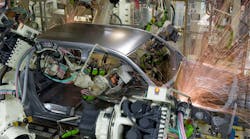The walls between production and IT -- that traditional separation between the producers and the enablers of production -- has given way under the pressure of big data and analytics, of new tools for immediate, constant communication, of robots and automation, of virtualization and slick, sexy gadgets that make the dirtiest jobs seem like space-age adventures.
That merger has changed manufacturing in profound ways, transforming what has for the past century been a careful choreography of physical, real-world efforts into a digital dance of information and automation. As a result, production is cleaner, faster and more efficient, and products are better, stronger and smarter.
All around, it has led to rapid, enormous breakthroughs, breakthroughs enough for some in the business to declare all technology the new king of manufacturing.
But Tim Platt, vice president of Information Systems and Information Security at Toyota Motor Engineering & Manufacturing North America, isn't so sure.
Platt sits at the controls of one of the tightest, leanest and most advanced manufacturing systems ever created. If anyone is in a place to hype manufacturing's digital transformation and the power of the tech-first industry approach, it's he.
But Platt sees a more nuanced evolution of manufacturing technology -- one that is settling into a comfortable place within the bounds and philosophies of its basic, traditional ways.
Recently he met up with IndustryWeek to explain his vision of Toyota's new technology-infused manufacturing ballet.
Toyota Q&A
IndustryWeek : Leading IT at Toyota puts you in an interesting position. The lean processes and Toyota Production System you are famous for tend to be very human-oriented and behavior-centric initiatives. How does IT fit in there?
Tim Platt: Historically, the manufacturing process has been choreography between people and machinery, and we're all familiar with that. But more recently advances have been made in the digital world that allow us to rethink what that choreographed dance should be.
It now becomes a choreographed dance of people, machinery and digital capability that don't contradict some of the principles -- in our case the Toyota production system and lean principles -- but actually enable them and make them even more a part of our business and our operations.
IW: But how do you keep that balance with all of the advances and opportunities technology presents? There is this theory that every business is a digital business or that every company is a technology company, however you want to say it. Do you think that's going too far?
TP: Certainly the capability of information technology, products and services are much more mature than they've ever been and they are changing and evolving on a weekly basis, it seems. But if you just focus on the technology, you're not going to have the success that you're necessarily looking for.
You really need to focus on the business process. In this case, it's the manufacturing process.
IT can really help you to go far, but it can also be your downfall.
So the opportunity is there, but the organization and the corporations have to be very careful to make sure that it is used effectively. You have to make it suited for your industry by architecting the pieces along with the human element to be most effective.
IW: Where is the line? How do you tell the difference between technologies that distract you from your core function and industrial technologies that help enable it?
TP: Well, any organization that comes to the table that says, "We have this new technology that's going to turn the world on its side," and doesn't understand the challenges of bringing that onto the factory floor is not going to be successful.
You have to understand that environment, understand the way that operates. You have to understand the history and the culture in order to really make the IT be utilized effectively.
And I think many organizations fail to do that. Both IT companies and corporations.
IW: And how do you know when you have it right? If this is all really a dance, how do we keep all of the dancers in step?
TP: We say that the dancers within a troop utilize similar steps, just like the work we're doing now on the manufacturing floor and the IT contributions are oftentimes utilizing very similar methods and mechanisms.
We must choreograph or ensure that the pieces come together, and we have to make sure that the human element, the machinery element and the digital elements operate together in harmony and in synchronicity with each other so that the end result works to the greatest advantage and the best manufacturing opportunity.




